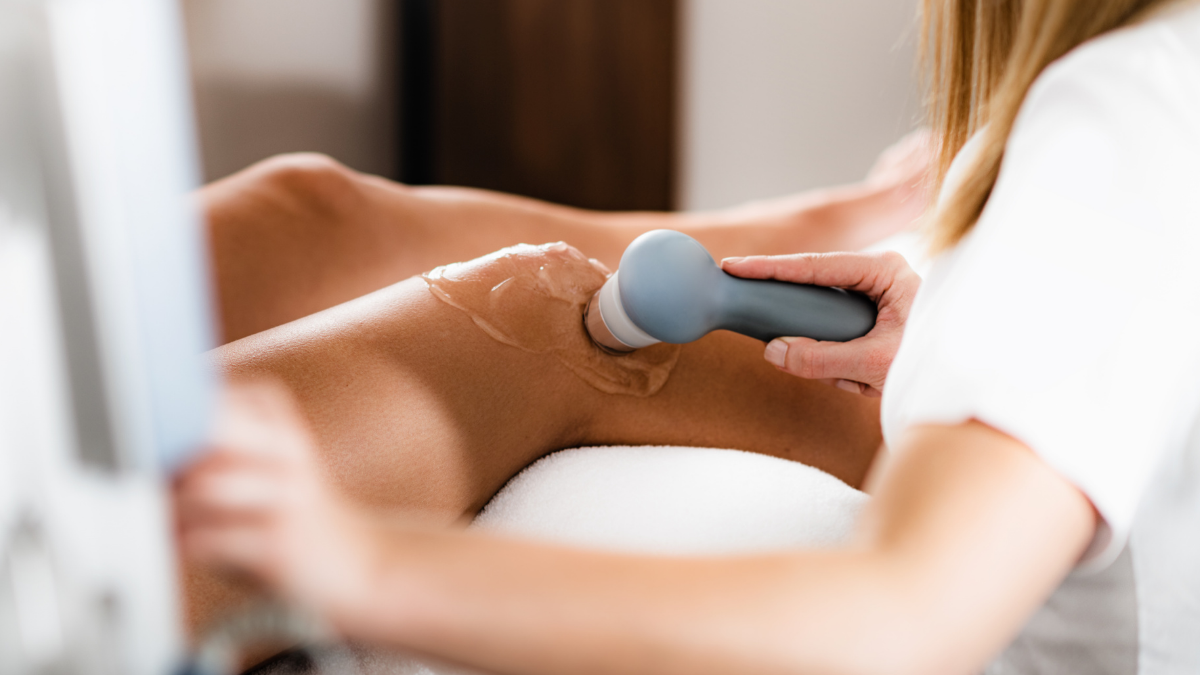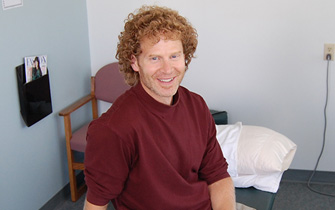Imagine finding a solution that can help alleviate pain, promote healing, and restore your vitality, all while being non-invasive and tailored to your unique needs. That’s ultrasound therapy, a valuable supplement to any treatment, fostering a healthier and more vibrant you.

What is ultrasound therapy?
Ultrasound therapy, also referred to as therapeutic ultrasound, is a treatment that uses high-frequency sound waves to promote healing and reduce pain. This non-surgical, non-invasive procedure is often used in conjunction with other physiotherapy techniques to help reduce inflammation in an injured area, increase blood flow, reduce muscle and connective tissue stiffness, and help to break down scar tissue.
What does ultrasound physiotherapy treat?
Ultrasound therapy can be effective in treating acute injury or chronic pain. Some injuries best treated by ultrasound therapy include:
- Arthritis
- Back pain
- Bursitis
- Carpal tunnel syndrome
- Fractures
- Frozen shoulder
- Joint pain and tightness
- Knee pain
- Muscle spasms
- Ligament injuries/sprains
- Muscle tears/strains
- Tendonitis
- Foot pain
- Rotator Cuff tear/tendonitis
- Plantar fasciitis
- Tennis elbow/golfer’s elbow
After an injury, inflammation is a natural part of the healing process, but excessive and prolonged swelling can impede blood flow and joint flexibility. Our focus is on early intervention to reduce inflammation through gentle and non-invasive treatments, avoiding aggressive techniques that may hinder rehabilitation.
Our experienced physiotherapists will craft a personalized treatment plan to address your specific condition, ensuring you receive the care you deserve. If you’re interested in ultrasound therapy, book a consultation with one of our physiotherapists today.
Benefits of therapeutic ultrasound therapy
The advantages of ultrasound therapy are numerous and can significantly enhance your healing process. Some key benefits include:
- Pain relief: Ultrasound therapy is effective in reducing pain, providing comfort and improving your overall quality of life.
- Increased circulation and metabolism: By promoting enhanced blood flow, ultrasound therapy aids in the delivery of vital nutrients and oxygen to injured areas, expediting the healing process.
- Breaking up scar tissue: Scar tissue can cause pain and restrict joint movement. Ultrasound helps by using high-frequency sound waves to break the fibres of the scar tissue down into smaller fragments. Depending on the amount of scar tissue, several treatments may be required.
- Increase flexibility and mobility: Ultrasound warms the tissues of muscles, tendons, and ligaments which increases their extensibility allowing them to stretch more. This added stretch increases the range of motion of joints and results in more flexibility.
How does ultrasound physiotherapy work?
Ultrasound therapy operates on the principle of sound waves beyond the range of human hearing. These waves are produced by a transducer, a handheld device that emits ultrasound energy. Ultrasound gel is used as this facilitates the transmission of these sound waves from the transducer to the skin and tissue.
A five-minute treatment of ultrasound in the affected area increases the temperature of the tissue being treated and increases blood flow, making the injured area more responsive to manual therapy. This increase in circulation helps with healing since all the properties that are vital to healing such as oxygen, specialized cells, proteins, and nutrients, are all located within the blood.
If the injury is still in the early stages of healing, longer intervals of ultrasound may be used. For best results, we have found that ultrasound works best as a supplementary technique to other treatments such as:
- Myofascial release — also known as manual therapy
- Intramuscular stimulation (IMS)
- Acupuncture
- Individualized strengthening and stretching program
What are the different types of ultrasound therapy treatments?
While there are technically different types of ultrasound therapy, they all share common principles with variations in parameters. These parameters, including intensity, power, and time (length of treatment), determine the specific characteristics of each treatment.
Pulsed ultrasound therapy
Pulsed ultrasound therapy is the same as all ultrasound therapy. The difference is that we change the parameters (heat, length, etc) so the tissues don’t heat up as much. Thermal ultrasound therapy can be used when a condition would be made worse with heat, (e.g. a new, acute, inflamed injury).
What to expect during ultrasound physiotherapy?
Embarking on ultrasound physiotherapy at Summit Physiotherapy is a seamless and reassuring process. Here’s what to expect during your session:
- Our skilled therapists gently maneuver the transducer over the targeted area, ensuring even distribution of sound waves.
- You may experience a slight warming sensation as therapeutic ultrasound waves are delivered to the affected tissue. This is a normal part of the healing process.
- Throughout the session, our therapists stay vigilant to your comfort levels. We proactively adjust settings to ensure the therapy remains both safe and effective.
Find A Ultrasound Physiotherapist In St. Albert
Not sure which ultrasound physiotherapist to work with? We can help! Contact our clinic today.
Frequently Asked Questions
Are there side effects of ultrasound physiotherapy?
Not every treatment is going to work the same way for everybody. No two injuries are identical and we all heal a little differently. That being said, ultrasound therapy may not work for some, but it can result in decreased pain, help improve the healing process, scar tissue reduction, and increased joint mobility.
Side effects of ultrasound therapy are rare. Some patients can experience mild discomfort during the treatment resulting from a periosteal burn, which occurs when the thin membrane around the bone becomes overheated. If the ultrasound is stopped when the pain is first felt, tissue damage is avoided and no harm is done.
When not to use ultrasound therapy?
As a passive therapy, ultrasound is considered low-risk, but it does have limitations and should not be used on:
- Young children
- Pregnant women (chest, abdomen, or back)
- Open wounds
- Heart (especially if you have a pacemaker)
- Reproductive organs
- Cancerous areas
- Areas with decreased sensation
Always consult a qualified healthcare provider for guidance on whether ultrasound therapy is appropriate for your specific condition. Contact us to find out if ultrasound therapy is right for you.
How often can you use ultrasound therapy?
Ultrasound therapy can be used as often as necessary, there are no limits. We usually use it for five minutes at a time during treatment. Whether we use it or not will depend on the client’s injuries.
Can ultrasound therapy be painful?
Ultrasound therapy should not hurt! If it does hurt, we ask that our client’s let us know if they feel any pain to avoid a periosteal burn. A periosteal burn is where the lining of the bone can overheat and burn.
How does ultrasound therapy for physiotherapy differ from a medical ultrasound?
Ultrasound used in physiotherapy is different from the ultrasound used for other medical purposes. Medical or diagnostic ultrasound is used to generate images of the internal structure of the body. It uses a transducer to send and then pick up the high-frequency sound waves as they bounce off the area where the ultrasound is applied. The waves that bounce back change depending on the type of tissue they make contact with and these changes are interpreted by a computer which then forms an image.
Ultrasound used in physiotherapy is therapeutic and uses a different frequency and does not have a sensor to pick up the waves after they’ve been sent into the body, so this type of ultrasound does not produce an image.
How does ultrasound therapy differ from shockwave therapy?
Ultrasound therapy differs from shockwave therapy in many ways, mostly that ultrasound therapy is designed to increase blood flow and reduce inflammation, whereas shockwave therapy is designed to also increase blood flow, but it does so by intentionally causing trauma to the tissues by way of using a shockwave.
Shockwave therapy starts the healing process when injuries are stuck in the inflammatory phase of healing, it essentially re-aggravates the injury to get the body to heal itself.
Is ultrasound therapy safe?
Yes, ultrasound therapy is safe! Our experienced physiotherapists won’t use it over any metal implants, the heart, the back or stomach (if someone is pregnant), the reproductive organs, any skin conditions, and cancer.
Does ultrasound therapy help with nerve damage?
No, ultrasound therapy cannot help with nerve damage.
Ready to find out if ultrasound therapy will work for you?
Ultrasound can be a useful part of a comprehensive treatment plan that helps you recover from injuries.
You want your body back at its optimal performance level, and we want to help get you there! If you’re injured, book an appointment with one of our skilled physiotherapists to get started on the best treatment plan for your recovery.





